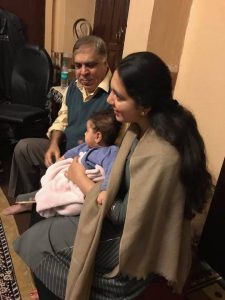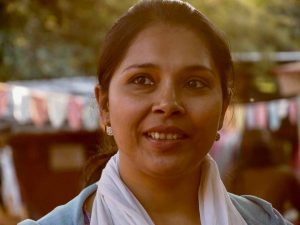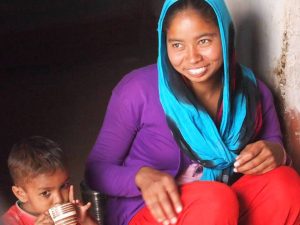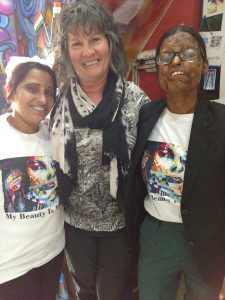India continues to haunt me and motivate my work. I’d like to share a few experiences that intersect with my mission of ensuring that all young people have a positive puberty experience. As I share the following vignettes from India, you will see what a small world this is and how much work is yet to be done.
Wendy L. Sellers
Vignette 1: March vs Silence
While we were visiting New Delhi, the capital of Indian, we passed a women’s march. I was surprised to see it, and frustrated that I couldn’t join in. Later, I learned that this was the first day of a 13-day Women Safety March that was taking place.[1] People were marching in protest of the gender-based violence that has been plaguing India. They were demanding reforms. As I pressed my nose longingly against the glass of our tour bus, I didn’t anticipate all the related events that would follow.
Vignette 2: Activism vs Fear
One of the highlights of my trip was a home visit with a Muslim father and daughter in Old Delhi. The father spoke first as the head of the house. He talked about the challenges he has faced trying to be a modern father. He allowed his daughter to delay her marriage so she could earn her college degree. By doing so, he went against their customs and the opinions of their extended family. He also approved of her marriage to a Hindu man…a big violation of cultural and religious norms. The young woman told her story next. In 2012, she became an activist following the gang rape and murder of young woman on a bus in Delhi.[2] She is now a leader in the movement that protests violence against women[3] and is often in the public view. She wants to make India a better place for her 5-month-old daughter. Her father spoke last. He expressed his fears for her safety. Through tears streaming down his face, he asked, “Where can I send my children so they will be safe?”
Vignette 3: Empowerment vs Poaching
Tiger Watch’s Ranthambore Tiger Preserve has been very successful in protecting endangered Bengal Tigers. One consequence of this success is that the wives of ex-poachers needed to find new ways to make a living. While working on environmental issues, Divya Khandal recognized the links between tiger poaching and the lack of opportunity and education, so she decided to provide both opportunity and training.[4] She founded and manages a women’s co-op called Dhonk that helps women obtain skills in textile art. Located just down the road from the Tiger Preserve, Dhonk trains and employs local women. They are empowered to earn money for their families by creating goods using local craft-making and sewing skills. Frosting on the cake… any profits made go back to the tigers. Because of her work, Divya was named one of Six-two’s 35 under 35 changemakers of 2018.[5]
Vignette 4: Education vs Child Bride
I visited a small village in rural Rajasthan that was displaced when the Tiger Preserve was set up. Twenty-five families (all related) were moved to a new location outside the Preserve with many supports from the government that provided improved housing, land for crops, running water, and “western toilets.” Among the villagers, our host was a 20-year-old woman who is the only one from her village who ever attended college. Once she graduates, she plans to return to her rural roots as a social activist, advocating for women’s rights. Already in her short life, she stopped an underage marriage by reporting it to the authorities.
In India, girls have a difficult time getting a good education. Most Indian marriages are arranged by parents in order to assure financial stability and maintain caste status.[6] This is especially true in rural areas. Since girls go live with their husband’s family after marriage, educating a girl is often considered a waste of family resources. Girl children are often married off shortly after they begin menstruation, so some girls try to hide the onset of menses in order to be able to continue going to school. Another barrier to getting an education is the lack of menstrual products. Many Indian girls miss school during menstruation because of the lack of menstrual products and unsanitary bathroom conditions. India has launched a Save the Girl Child campaign to promote education for girls because they recognize that education improves conditions for everyone.
Vignette 5: Sheroes vs Acid Attacks
India has the highest rate of acid attacks in the world. Acid attacks involve one or more people throwing acid on another person in order to harm, disfigure or kill.[7] Although Indian law has required the regulation of acid sales since 2013, it is still very easy to purchase acid cheaply and anonymously. In fact, about 1,000 acid attacks occur each year across India, and women are usually the targets.[8] The impact on the victims of acid attacks is life-altering at best and life-ending at worst. Women who are disfigured and/or blinded by acid live in isolation, shame, and poverty. Many take their lives.
While in Agra, I visited Sheroes Hangout,[9] a café and lounge that is run by women who have been impacted by acid attacks. Sheroes is more than a way for these women to earn a living; it is a community of support. By working at Sheroes, acid attack victims can raise awareness of the issues and challenge their culture’s values around gender and appearance. It was such an inspiration to meet the sheroes at Sheroes Hangout and learn about their mission. Their activism will make a difference in the lives of others who have been harmed by this form of gender-based violence.
Main Take-Aways for Vignettes from India:
- More than ever, I am recognizing that my mission is not limited to schools in America. The issues related to the lack of sex education are universal. Read more about sex education in India.
- As I observed so many pointed examples of gender-based violence in India, I was struck by a comparison between India and the United States. India is rated as the worst nation in the world to be a woman. The U.S. is rated 10th worst and is the only Western democracy on the list.[10],[11],[12]
Lingering Questions:
- How does gender-based violence in the United States look?
- How is it similar and different from gender-based violence in India?
- What role does sex education have in eliminating gender-based violence?
- How do these vignettes from India inform your work?
Sign up to receive a FREE sample lesson to see what Puberty: The Wonder Years is all about.
Updated 2021-10-1
[1] https://www.ndtv.com/india-news/delhi-womens-panel-seeks-complete-ban-on-sale-of-acid-in-city-2003226
[2] https://www.theguardian.com/society/2017/dec/03/five-years-after-gang-murder-jyoti-singh-how-has-delhi-changed
[3] https://www.opendemocracy.net/en/5050/indias-anti-rape-movement-redefining-solidarity-outside-colonial-frame/
[4] https://yourstory.com/2016/07/dhonk
[5] https://www.contiki.com/six-two/dhonk-crafts-centre-northern-india/
[6] https://www.culturalindia.net/weddings/arranged-marriage.html
[7] http://jurip.org/wp-content/uploads/2018/03/Siddharth-Baskar-1.pdf https://www.bbc.com/news/world-asia-india-23358264
[8] http://gendermatters.in/2017/05/acid-sale-rules/
[9] https://www.sheroeshangout.com/
[10] https://www.cbsnews.com/news/us-10-most-dangerous-country-for-women-thompson-reuters-survey-amid-metoo/
[11]http://fortune.com/2018/06/27/thomson-reuters-us-top-ten-most-dangerous-countries-for-women/
[12] https://www.reuters.com/article/us-women-dangerous-poll-exclusive/exclusive-india-most-dangerous-country-for-women-with-sexual-violence-rife-global-poll-idUSKBN1JM01X



